|
February 2, 2006
Presenting: Esther and Li, two Toronto-based
women, create a documentary during a Holocaust Education Trip
My dentist, Dr. Rajiv Arya, and I have
the most amazing conversations while he examines the precarious
state of my molars. During my dental appointments he has been telling
me about his interesting trips to Nepal and to South Africa, and
he also mentioned a holocaust education trip he participated in
a few years ago. He told me that two young women that were part
of the trip did a documentary about it, and I knew then that I had
to meet these two Toronto women.
A few weeks ago I met Esther and Li, two young local professionals,
and I had an extended chat with them about their backgrounds and
about their experience during this Holocaust education trip. We
also discussed the making of their documentary "Those Who Lie
Beneath" which they produced independently with great determination,
effort and persistance.
I was also fortunate to be able to see a rough cut of their documentary,
and it had a strong impact on me. Over the years I have seen many
Holocaust documentaries, but what makes this one different is the
unique perspective of 3 young Canadian women of Jewish, Chinese
and German descent who all participated in the creation of this
documentary. The documentary transcends religious affiliations and
sends a powerful message to all of us, regardless of religion or
background.
Here are Esther and Li, to talk about the story of the making of
"Those Who Lie Beneath":
1. Please tell us a bit about yourselves, what is your
background, how did you get to know one another?
Esther: I grew up and was educated in Toronto. I have an
undergraduate degree in Economics and a Law degree. I have worked
as in-house counsel at a Canadian television production company
for the last 5 years. I met Li when I began working at this company.
Li: I am Chinese-Canadian, but born in Laos. I came to
Canada at the age of 2 and have lived in Montreal, Calgary and Toronto.
I think having grown up in various cities across Canada, having
to make new friends, and as well having to adapt to the differences
in culture and society in each city has made me open to meeting
different people and wanting to learn about their culture. So, in
this sense, I was very open to learning about this part of Jewish
history. As for meeting Esther, we met while working at a Toronto-based
television production company about 5 years ago.
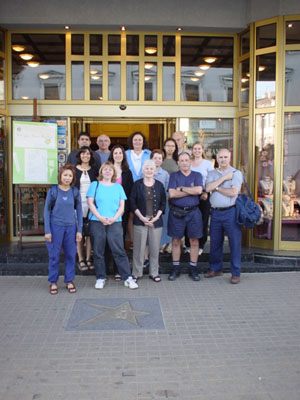
Tour Group
2. What were the reasons for each of you that made you decide
to go on this trip and how did the idea of creating a documentary
during this Holocaust education trip come about? What are your goals
for this documentary?
Esther: I first heard about the anti-discrimination tour
through friends and became interested in going on the trip purely
as a participant when I attended an information session. I noted
that the people at the session ranged in ages and came form various
ethnic backgrounds. I immediately wondered why these people, none
of whom were Jewish, were interested in spending their summer vacation
visiting death camps.
The next day I mentioned the trip to my boss at work thinking perhaps
the company may wish to make a documentary about the trip. My boss
thought it was an interesting idea but to my surprise suggested
that I take the reigns and make the documentary independently.
My background was not in film making so I approached Li to see
if she would be interested in helping me make the documentary. She
said yes and through our own limited resources and the goodwill
of many, we made the documentary.
At the time of writing this, Li and I have completed a polished
rough cut and will shortly be commencing the marketing of the documentary.
We would like to enter our documentary into some festivals, obtain
a television broadcast license and also get our documentary into
the school system.
Li: Esther first mentioned to me that she was interested
in going on an anti-discrimination tour to Germany and Poland, and
that she would be going on a trip with participants who were of
different cultural and religious backgrounds. Then she mentioned
how she thought this would be a great documentary and asked if I
would like to participate in the making of it. Since my background
is in television production, I thought this was a great opportunity
to put my training into practice.
Esther as well, got me questioning myself. At that time, the Holocaust
was simply a page in the history books for me. I had no thoughts
of it beyond what I had learned in school, and I had no emotional
ties to it. Yes, I did know that 6 million Jews died in the Holocaust,
but no, I really did not know what happened - the systematic murders
of millions of Jews, the horrendous torture of so many people, that
this was the worst hate crime that man has ever known. And so I
realized that if I didn't really know, and that if I could not really
associate with such genocide or any others that have happened since,
then that meant that so many others probably felt the same. And
in the end, I wanted to make this documentary for my own self knowledge
and betterment. I hope that the documentary will help touch those
who are not directly affected by the Holocaust become affected by
it like me.
3. Please tell us a bit about the preparations leading up
to the trip.
Li: Well, when it became clear that we were going to do
this documentary, I went on an obsessive research binge. I read
anything I could get my hands on about the Holocaust because I felt
inept on the subject. I became quite haunted by what I was reading
and the images that I was seeing, but still I couldn't get enough
of it.
As for the actual documentary process, we originally had a director/cameraperson
on board, but because of the lack of financial backing, he had to
step aside. So, we went on a search for a camera person. After meeting
with several individuals, we came upon Sandy, who, as it turned
out, was a former classmate of mine at Ryerson. The timing couldn't
have been more perfect. At that time, she was teaching at Ryerson
which meant that she had the summer off to come with us on the trip.
As Sandy took care of the technical aspect, Esther and I had to
make sure that we were ready to creatively and legally shoot in
Germany and Poland. There needed to be, creatively, a focus on the
documentary and legally, we needed to obtain permits from the sites
we were visiting and releases from the individuals we were filming.
Just prior to the trip, we pre-interviewed many of the trip participants
who lived in Toronto, not only for them to get used to the idea
of having two cameras follow them around, but as well for us to
get a sense of who they were and to find out why they were going.
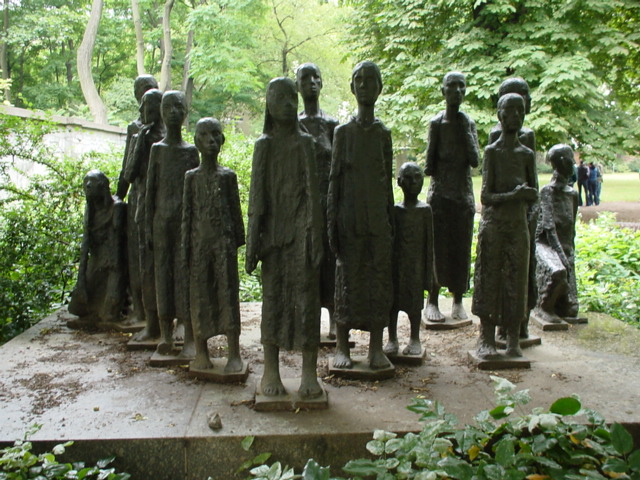
Sculptures in Old Berlin Jewish neighbourhood
4. What was the overall itinerary for the trip? What was
the makeup of the travel group?
Li: Our group met in Berlin, Germany. Our tour began there
because the group leaders wanted us to get a sense of where it all
started. We visited sites like the Topography of Terror, Wannsee,
the Jewish Museum, Ravensbrueck Woman's Camp. Then we were led into
Poland, where we really got a sense of what happened during the
Holocaust from visiting concentration camps like Majdenek and Treblinka.
As for the makeup of the group, it was extremely diverse in age,
religion and culture. The age group ranged from early 20s to late
60s, from Catholics to Hindus, and from a German to a Jew. The diversity
was what made this interesting.
5. What are your impressions of how people in Germany have
been dealing with this era of history?
Esther: I had never been to Germany before and it was strange
for me to be there, having seen so many Holocaust films that obviously
portrayed Germany and Germans in a negative light. After meeting
and speaking with our tour guide and the various individuals we
met there, I learned that Holocaust education is strong in Germany
and young Germans bare the shame of their grandparents' past. For
the most part, it seems that Germans do not deny the role their
country played in the Holocaust. It's black and white in the context
of liability, no gray area as perhaps some Poles would argue.
6. Please comment on your next stops in Poland. What did
you see and what were your impressions?
Esther: Without revealing too much of the documentary,
let's just say that unfortunately some of the negativity I held
prior to going to Poland remains after visiting Poland. While we
met some wonderful people there, we did see anti-Jewish graffiti
on walls of buildings and our own group was on the receiving end
of some anti-semitic remarks by some Polish teenagers, the irony
being that except for me, members of our group were not even Jewish
. Furthermore, I am not convinced that the average Pole acknowledges
Poland's role as perpetrator during the Holocaust. No doubt there
were Poles who were simply bystanders and also Poles who tried and
did assist Jews, but to deny that they were perpetrators also is
to deny fact.
Li: From Berlin, we boarded a train headed towards Warsaw,
Poland. This to many of us was quite an eerie way to travel there.
Though our experience was not comparable to the victims of the Holocaust
who were cattle carted into the trains, with no food, no water,
and with no knowledge as to their final destination, we still were
haunted by it.
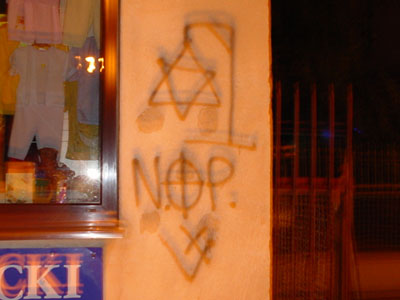
Lodz graffiti
7. You also visited 3 Nazi death camps: Treblinka, Auschwitz
and Majdanek. What was your visit to Treblinka like? Where is it
located, what does it look like, what did you feel?
Esther: Treblinka is located in the countryside. The camp's
barracks had been destroyed at the end of the war. Today, Treblinka
is filled with hundreds of jagged rocks of various sizes over green
grass that has grown over the horrors. The rocks represent the different
cities from where Jews were deported. The larger the rock, the larger
the Jewish population that once was.
To me, Treblinka felt like a huge cemetery. The jagged rocks are
extremely powerful. This camp probably evoked the strongest emotional
reaction in me of all the camps Though the ugliness of the camp
and the actual barracks were no longer there, I was left to imagine
the horrors that took place on the grounds I was walking on. Furthermore,
based on research my father conducted, I knew that many of our family
members from Poland who perished in the Holocaust had been deported
to Treblinka.
Li: When we arrived at Treblinka, I was not sure as to
what to expect there. I had very little information on the camp,
but knew that it was one of the larger and more famous camps. To
get to Treblinka, we traveled by bus along a small rural road, through
small villages and passing farms. As we arrived, we noticed that
the camp was situated in a very dense forested area, so we couldn't
see anything as we approached.
As I was doing 2nd unit camera work - which means I was gathering
background footage to be used along with Sandy's footage - I had
to get ahead of the group, and catch their reactions as they were
going into the camp. I was a bit nervous to go ahead on my own.
I wasn't sure if I was going to see tattered barracks, remains of
a crematorium, images of the horrors that happened there. But as
I traveled along the path carved out in the wooded area, I finally
came to a clearing, a stretch of land several football fields wide.
This was not what I expected. I was overwhelmed by the sight of
all the jagged rocks, but felt a sense of relief and as well peace
for those who died there, for nature certainly has taken over and
covered the evil that once was there. It seemed as though many of
the group members felt the same way. We all spread out and had moments
to reflect on our own. In the end, we came together and said a prayer
to those who died there. Though many of us were not from the same
religious background, the prayer was the most emotional and most
spiritual moment of the trip for me.
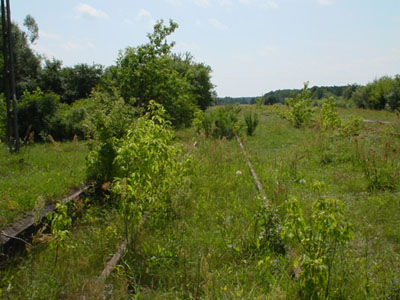
Railway tracks leading to Treblinka
8. How did your visit to Auschwitz unfold? Where is it located,
what does it look like? Please describe your experience.
Li: Auschwitz is a known concentration camp in Poland.
The sheer size of the camp, or in actuality camps as there were
3 different sites, was enormous. My impression of the camp as it
is today was that it was a well oiled machine - unlike other camps.
They had set-up tour guides to escort the visitors, and had set
the camp up as more of a museum. It wasn't as raw as what I expected.
As for our documentary, this was the only location where we were
unable to get a permit to film unless we paid a permit fee. Since
we were unable to do so, we left this out of our documentary.
9. Please tell us about your visit to Majdanek.
Esther: Despite it being a beautiful sunny day that day,
black crows flew above and echoed throughout the camp adding to
the rawness of the place. Surrounded by barbed wire, we saw rows
of barracks. The barrack filled with people's shoes particularly
left a lasting impression. We also saw the crematorium, gas chambers,
a dissection table and a huge monument filled with ashes and bones
of those who were murdered. Unlike the other camps we had visited
on the trip, Majdanek didn't leave that much to the imagination.
The remnants of horror were right in our faces.
Perhaps most shocking of all was the proximity of the camp to the
city. There is no way that people living in the city did not know
what was going on at this camp. It was right in their backyards.
10. There were some interesting dynamics in your travel
group and different viewpoints must have emerged. Please comment
on some of the interesting conversations and reflections that emerged
during the trip.
Esther: As always in a group dynamic, people have different
opinions and it was no different on our trip. I had perhaps the
greatest difference of opinion from several in the group about Treblinka.
Some in the group began speaking of the nature there - the grass,
the flowers, the butterflies and how it had grown over the horrors
that once took place. These people found a sense of hope at Treblinka.
I on the other hand couldn't understand someone finding hope at
a death camp. I felt their sense of hope was some sort of defense
mechanism. I took the place for what it had been, a death camp,
a place of horror, of sadness and today a memorial. Interestinglyas
the trip went on and we visited more camps that contained evidence
of the atrocities ie . crematorium, gas chambers, etc., I didn't
hear people speaking of hope anymore.
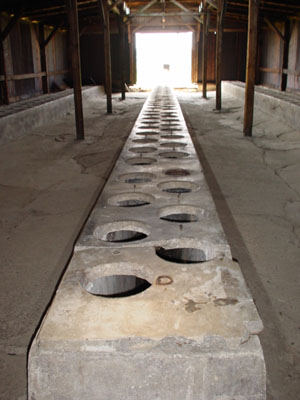
Toilets in barrack
11. For Esther: please tell us about your special side
trip to Kielce, your grandparent's birth town.
Esther: It was very interesting for me to visit Kielce.
I had the address where my grandfather had lived but when I found
the street, the actual building was no longer there.
I then went to the Kielce Jewish Cemetery in an attempt to find
the graves of family members. To my shock, when I arrived I saw
that the cemetery had been destroyed. What mainly remains are but
a few headstones all bunched together in a square. There are no
longer markers at the actual graves. All destroyed. So, my mission
to find remnants of my family's past had failed. It was disappointing
but in hindsight, I suppose I shouldn't be that surprised.
12. Your camera person and the documentary's narrator was
a young woman of German descent. Was this a deliberate decision?
Please tell us about her experiences on the trip.
Esther: It was not a deliberate decision to have a camera
person of German descent. What started out as just a job for her
became something much more. During much of the trip, Sandy would
admit she hid behind her camera and did her job. However, there
were definitely moments and places where she became emotional. To
see how Sandy emotionally unfolds, watch the documentary.
13. Please tell us about all the work involved in creating
and finishing the documentary after you came back.
Esther: When we came back, we put a little distance between
ourselves and the trip. Even though we were working on the trip,
it was an emotionally charged experience and we felt it would be
a good idea to process the trip on our own time and then get back
to the work of editing.
We were lucky to find a wonderful editor who was willing to donate
his time to help us edit the documentary. We had so many hours of
footage and it was a huge job.
Nearly a year after our trip we did follow-up interviews with some
of the participants and then had even more editing to do.
We then had some music composed for the film, some graphics added
and we completed a polished rough cut in time for a presentation
of the documentary to 2 test audiences at a Chicago University campus
where we had been invited.
Li: And with all that done, we will begin submitting the
documentary into festivals, with the ultimate goal of getting it
into the educational system, to be used as a teaching tool. We would
like our message to be put out there because hatred still exists
and we hope that through learning in a contemporary setting about
the Holocaust (a most extreme example of hate) we will learn not
to hate and discriminate and to accept others.
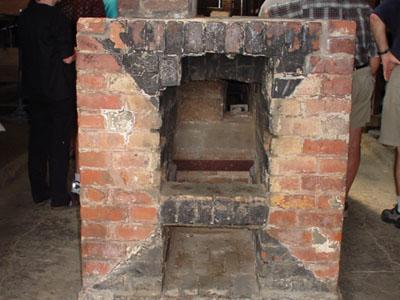
Crematorium remnant
14. Looking back on your experiences on this trip and creating
this documentary, what are your key insights and learning experiences?
Esther: The Holocaust is not just a Jewish history. It
is also as relevant today as it has ever been. If we do not learn
from history, what will prevent such atrocities from happening again?
Certainly genocides are currently happening - obviously history
has not taught us enough.
Li: Exactly what Esther said above. This was a life altering
trip, and I recommend anyone who has the opportunity to visit Germany
and Poland, or any countries that were effected by the Holocaust,
to witness for themselves what happened in the past. The Holocaust
becomes a reality and not simply a page in the history books.
Thank you both, Esther and Li, for your sharing your unique perspectives
with us. I wish you all the best and lots of success for your documentary.
Related Articles:
The interview
preview provides further background about this project
My own reflections
60 years after WWII and my very personal connection to this era
Susanne Schleyer: A German artist/photographer
confronts German history
|